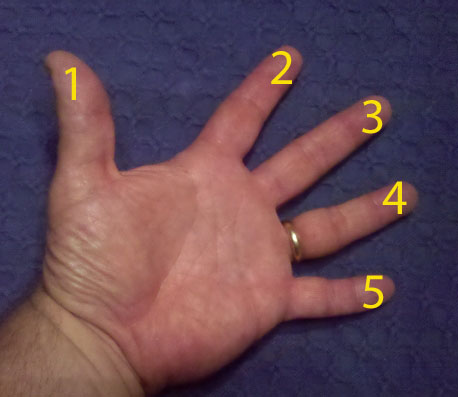Blog
mountain dulcimer
Playing Authentic and Plagal Tunes
Here are two words that may be unfamiliar to you, but which I find most helpful for determining where to look to play tunes on both mountain and hammered dulcimers: Authentic and Plagal. (for more on Plagal, see below)
Authentic Tunes are those whose notes are generally found between Do and the octave do.
Plagal Tunes (in a use of the term by ethnomusicicologists) are those which are centered on Do, from Sol below Do to sol above Do. This is illustrated by the chart below:
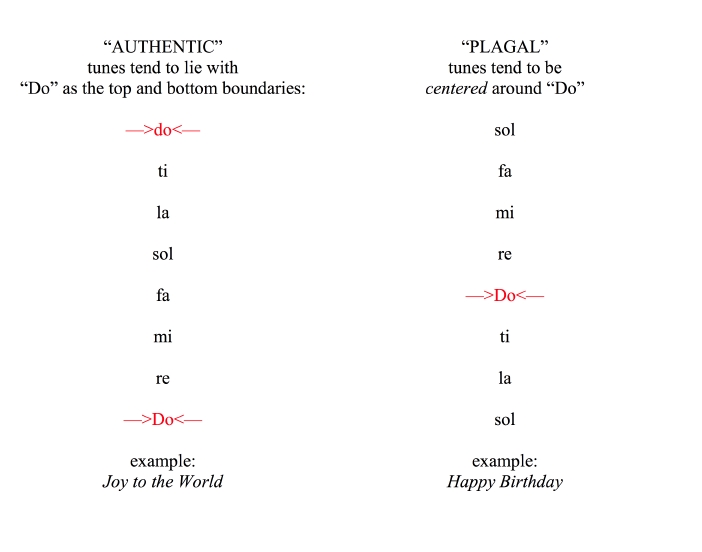
Now ho…
Give the Gift of Dulcimer Lessons!
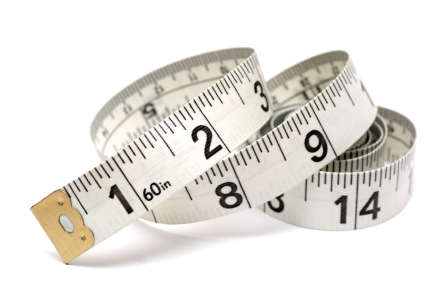 Finding just the right gift for someone who plays dulcimers can be difficult because the preferred instruments and accessories are so personal. My father-in-law once said that about camera lenses when I asked to have one as a gift; and he was right! They can't be picked off of the rack—they have to be tailored to each individual.
Finding just the right gift for someone who plays dulcimers can be difficult because the preferred instruments and accessories are so personal. My father-in-law once said that about camera lenses when I asked to have one as a gift; and he was right! They can't be picked off of the rack—they have to be tailored to each individual.So here is the perfect gift: support and challenge that nurtures each individual's growing skill-set and helps them play the music they want to play, i…
String-Side Up/Absolute Beginner Lesson Series
by Steve Eulberg Congratulations! You've got a dulcimer and now you're ready to play it. And we've got a brand-new series of lessons to help you successfully meet that goal.
This String-Side Up/Absolute Beginner Hammered Dulcimer and String-Side Up/Absolute Beginner Mountain Dulcimer lessons on www.dulcimercrossing.com is designed to take you from square one in a step-by-step fashion, through sequential lessons designed to answer your questions, demonstrate and encourage best practices and …
Lance Frodsham Plays Epinette
by Steve Eulberg On my recent tour of the Pacific Northwest, I was able to finally meet Lance Frodsham of Vancouver, Washington. Lance is a teacher and performer of the mountain dulcimer with several recordings and books of music for dulcimers published by Mel Bay. He is also one of the coordinators of the annual Kindred Gathering (which celebrated its 37th gathering in the Pacific Northwest this past August!)  Lance and I have corresponded but had never met face to face, or had the opportunit…
Lance and I have corresponded but had never met face to face, or had the opportunit…
Mountain Dulcimer: "1/2 the frets, 1/2 the strings but All the Music!"

The mountain dulcimer has "Half the strings, and half the frets, but ALL the music," so quipped my friend and colleague, Joe Collins at the Western Carolina Dulcimer Week this summer in Cullowhee, NC.
He was comparing a 3-string, diatonic mountain dulcimer to a 6-string, chromatic guitar.
Many people like ask me if a dulcimer is "easy to play."In my experience there are no instruments that are "easy to play." But, there are some instruments which are more accessible than others.
A devout appreciat…
Playing Homer Ledford's Dulcimer
by Steve Eulberg While one tour this month in Bettendorf, Iowa, I was given the opportunity to provide workshops for hammered dulcimer players at the home of Linda & Reg Shoesmith. On the morning I was leaving, Linda brought out a treasured "find" to share: A mountain dulcimer built by Homer Ledford, one of the famous Kentucky builders of the 20th century!  A unique feature of this instrument is that the only fret that went under all 4 strings was the 3rd fret.
A unique feature of this instrument is that the only fret that went under all 4 strings was the 3rd fret. 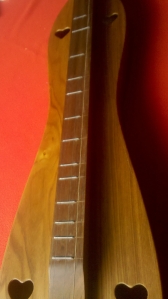
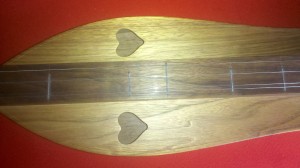

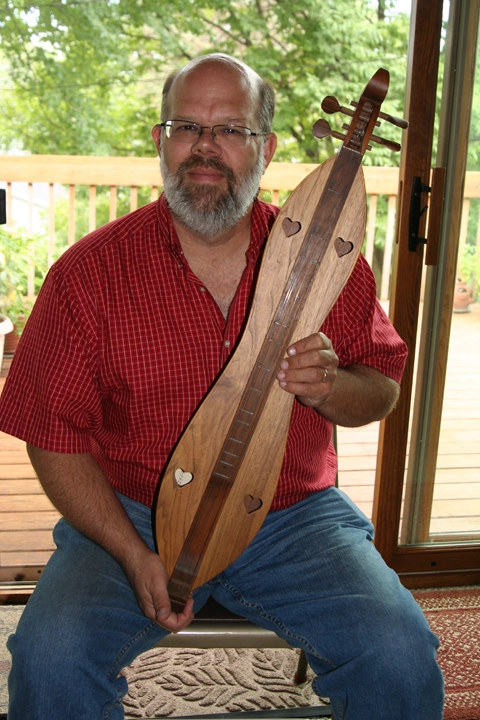 What an exciting opportunity! …
What an exciting opportunity! …
How should I practice? The 5 Finger-Regimen
by Steve Eulberg I hear this question all the time from students in my private studio, from my Jamplay.com guitar students and dulcimercrossing.com students. The Five-Finger Practice Regimen is what I always suggest:
It doesn't matter what instrument you play, it will sound better (and therefore encourage your practice) if it is in tune. [Note for hammered dulcimer players: Tune ALL the strings on the instrument, not just the ones you use most!! A significant part of the hammere…
Whooing into the hole
WHAT IS IT?
This bit of dulcimer history always amazes people when I tell them about it.
When I built my first mountain dulcimer (from a FolkRoots kit in 1980), the instructions told me that once it was strung up I was to "whoo" into the soundhole to find out to which pitch I should tune the lowest string.
 I was aware of this kind of "tuning" method with reference to native american flutes, which each have their own unique voice, but it was new to me, a guitar and mandolin player. …
I was aware of this kind of "tuning" method with reference to native american flutes, which each have their own unique voice, but it was new to me, a guitar and mandolin player. …Categories
- News (8)
- Events (4)
- News (6)
- Events (4)
- subscriber news (233)
- mountain dulcimer (109)
- hammered dulcimer (112)
- uncategorized (6)
- lessons (189)
- mountain dulcimer (198)
- hammered dulcimer (154)
- history (22)
- music theory (40)
- octave (1)
- plagal cadence (1)
- dulci-bro (73)
- fingerpicking (3)
- fingerstyle mountain dulcimer (4)
- nina zanetti (4)
- aeolian (2)
- dorian (4)
- ionian (3)
- lydian (1)
- mixolydian (3)
- modes (2)
- traditional (2)
- tuning (4)
- music education (2)
- NSME (1)
- standards (1)
- drone (3)
- folk alliance (1)
- jonah brody (1)
- koto (1)
- chromatic mountain dulcimer (7)
- sam lee (1)
- scottish folk song (1)
- linda ratcliff (5)
- practice (26)
- chromatic mountain dulcimer (66)
- dulcimercrossing.com (2)
- erin rogers (7)
- building (8)
- black mountain (1)
- jerry read smith (1)
- Joshua Messick (1)
- song of the wood (1)
- don pedi (5)
- fiddle whamdiddle (9)
- miss mcleod (2)
- steve eulberg (30)
- vi wickam (9)
- buying (1)
- choosing (1)
- purchasing (1)
- orphan girl (1)
- copyright (1)
- amplification (2)
- contact pickup (1)
- eulberg (4)
- microphone (2)
- pickup (2)
- berkeley (1)
- colorado (2)
- festivals (4)
- kentucky (1)
- scholarship (1)
- western carolina (1)
- noter (2)
- clubfooted jib (1)
- dgd (2)
- dgd tuning (1)
- special event (31)
- david massengill (2)
- reverse ionian (1)
- chuck boody (1)
- concertina (1)
- deedee tibbits (1)
- dulcimer (7)
- evart (1)
- evart funfest (1)
- linda foley (1)
- michigan (1)
- original dulcimer players club (1)
- fingerstyle (11)
- gebhard woods (1)
- technique (1)
- harmonics (1)
- dan delancey (2)
- june apple (1)
- linda thomas (3)
- modal (1)
- expression (1)
- playing expressively (1)
- dulcimer pledge (1)
- christmas (2)
- nativity (1)
- DAC (2)
- minor more (1)
- mississippi sawyer (1)
- holiday (5)
- joy to the world (1)
- jingle bells (1)
- reverse ionion (1)
- hand independence (1)
- hand separation (1)
- lullabye of muffe (1)
- tina gugeler (1)
- absolute beginner mountain dulcimer (1)
- beginner (2)
- mountain (3)
- string-side up (1)
- absolute beginner hammered dulcimer (1)
- blog (2)
- dulcimercrossing. (1)
- topics (1)
- blues (4)
- resonator (4)
- dulcimer orchestra (2)
- kitty puss (1)
- mike clemmer (1)
- noter style (2)
- jam survival (7)
- butch ross (3)
- looping (1)
- intro (4)
- neal hellman (4)
- erin mae lewis (9)
- rehearsal (3)
- italian (1)
- lauda (1)
- irish (1)
- slipjig (1)
- rhythm (2)
- robert force (2)
- tuner (1)
- exercises (1)
- scales (1)
- devotions (3)
- hark advent (1)
- the glad sound! (1)
- chords (3)
- chromatic (4)
- erin (1)
- theory (7)
- advent (5)
- preparation (4)
- stir up (1)
- appalachia (4)
- hillbilly (1)
- mountains (1)
- traditional music (1)
- dampers (1)
- hearts of the dulcimer (3)
- patricia delich (2)
- wayne jiang (2)
- appalachian (1)
- John Jacob Niles (1)
- Live Events (28)
- Premium Level Membership (2)
- habits from the muse (1)
- progress (5)
- support (1)
- Anna Muckova (1)
- cimbalom (1)
- CWA (1)
- Czech Republic (1)
- Magdalena Muckova (1)
- nonsuch (1)
- Slovak Republic (1)
- podcast (1)
- aubrey atwater (2)
- jean ritchie (2)
- log-in (1)
- update (1)
- lucky (1)
- performance (8)
- preparing (1)
- study (1)
- dulcimers (1)
- wendy songe (2)
- bluegrass (2)
- growth (1)
- resolutions (2)
- risks (1)
- capo (1)
- snark (1)
- fiddle (61)
- criticism (2)
- judy klinkhammer (1)
- miles davis (2)
- wrong note (1)
- live and let live (1)
- style (1)
- barlow knife (1)
- old school old-time (2)
- marie kirby (1)
- bass mountain dulcimer (1)
- elaine conger (1)
- larry conger (1)
- practice smarter (5)
- musical journey (1)
- piano (1)
- calm (1)
- dog (1)
- su la li (1)
- bluebird cafe (1)
- inspiration (3)
- new input (2)
- trust (1)
- practice space (2)
- quite (1)
- how to practice (6)
- you are what you practice (1)
- workshop (5)
- rich chords (2)
- kaitlin pabo-eulberg (1)
- hooked on dulcimers (1)
- humor (1)
- blue water thinking (1)
- creativity (2)
- environment (2)
- original tunes (1)
- 1+ fret (1)
- chopin (1)
- classical (1)
- assessment (1)
- skill levels (1)
- waltz (1)
- caledonian club (1)
- ensemble (1)
- group (1)
- dulci-tune (1)
- tuning game (1)
- love (2)
- workout (1)
- learning (6)
- teacher (6)
- self-taught (1)
- how long (1)
- jam sessions (6)
- learn to play (1)
- strategies (2)
- fariña (1)
- mimi (1)
- pete seeger (2)
- rainbow quest (2)
- goals (1)
- planning (1)
- backing tracks (6)
- matthew dickerson (2)
- concert (1)
- erin mae (2)
- guitar (5)
- deborah hamouris (3)
- dj (2)
- freight and salvage (1)
- classic (1)
- licks (1)
- rock (1)
- berkeley dulcimer orchestra (1)
- premiere (1)
- banjo (1)
- frank proffitt (1)
- frank warner (1)
- tom dooley (1)
- baker (1)
- binding (1)
- blue lion (1)
- bob (1)
- gluing (1)
- janita (1)
- live (1)
- tips (1)
- spouse (1)
- amplified (1)
- DI box (1)
- digital interface (1)
- sound reinforcement (1)
- 2nd Set Concert (2)
- contest (1)
- flash mountain dulcimer brigade (2)
- JimJim & the FatBoys (1)
- Pecan Grove (1)
- walnut valley festival (2)
- winfield (1)
- wvfest (1)
- thinking (1)
- case (1)
- cross-legged (1)
- grip (1)
- safe dulcimer (1)
- sit (1)
- slip (1)
- stand (1)
- stool (1)
- strap (1)
- learn (3)
- mistakes (1)
- successes (2)
- herbie hancock (1)
- improvising (1)
- jazz (2)
- lois hornbostel (2)
- wrong chord (1)
- atlantic (1)
- barbara allen (1)
- frank profitt (1)
- scots-irish (1)
- chord wizard (1)
- diatonic (2)
- equi-distant (3)
- tom strothers (1)
- tool (1)
- busker (1)
- tsimbaly (1)
- ukraine (1)
- ukrainian (1)
- calendar (1)
- schedule (1)
- baritone (1)
- concert window (3)
- katie moritz (1)
- faq (1)
- frequently asked questions (1)
- logged in (1)
- navigation (1)
- old time (1)
- patreon (1)
- shape-note (1)
- special (1)
- carrell (1)
- geoff reeve-black (1)
- malvern (1)
- presnell (1)
- articulations (1)
- chicken reel (1)
- conger (1)
- soldier's joy (1)
- basic level membership (1)
- caring for your instrument (1)
- winter weather (1)
- god rest ye (1)
- rhythmic displacement (1)
- builder (1)
- tam kearney (1)
- toronto (1)
- don neuhauser (1)
- slide (1)
- ashley ernst (1)
- dan and angie landrum (1)
- dpn (1)
- dulcimer players news (1)
- dulcimersessions.com (1)
- maddie macneil (1)
- arkansas traveler (1)
- Mark Alan Wade (2)
- 3d playing (1)
- playing across the strings (2)
- chord symbols (1)
- understanding chords (3)
- dulcimer club (1)
- class (1)
- habits (1)
- skills (1)
- jimmy driftwood (1)
- failures (1)
- hours (1)
- youtube (1)
- arranging (1)
- bill robinson (1)
- cold winter night (1)
- karen mueller (3)
- jig (1)
- DAd tuning (1)
- hyfrydol (1)
- hymn (1)
- 2020 (1)
- premium (1)
- gounod (1)
- hitchcock (1)
- dan evans (1)
- spotted pony (2)
- steveeulberg (1)
- nylon-string (1)
- stephens lutherie (1)
- musical devotions (1)
- award (1)
- fernando sor (1)
- hammered (1)
- understanding (1)
- lent (1)
- leap forward (1)
- power of music (2)
- sharing (1)
- persistence (5)
- Practice (4)
- routine (1)
- tour (1)
- new website (1)
- arrranging (1)
- celtic (1)
- single jig (1)
- mountain dulcimer (3)
- busking (1)
- audio (1)
- playback (1)
- protection (1)
- adaptations (1)
- dulcimer acquisition syndrome (1)
- dulcimer acquisition disease (1)
- contests (1)
- lessons (1)
- identify (1)
- apps (1)
- motivation (1)
- hands (1)
- In Memoriam (1)
- guitar (1)
- archive (1)
- concerts (1)
- mountain dulcimer (2)
- hammered dulcimer (1)
- lessons (1)
- workshops (1)
- self-assessment (1)
- learn (1)
- greek (1)
- mindset (2)

